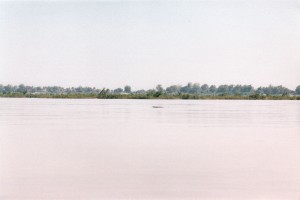[In January 2003 I accompanied an expedition that was conducting a survey of river dolphins on a stretch of the Mekong River in Cambodia. The expedition was led by Isabel Beasley, who was then a PhD student specializing on Orcaella brevirostris: also known as the ‘Irrawaddy Dolphin’ this species is found in many Asian river systems and deltas. The journal I kept during the expedition will appear on this site as a continuous series of posts. This is part 2 of the series.]
Kratie, Cambodia, January 6, 2003
At 4 in the afternoon we went out to the observation platform where Isabel spends most of her time when she is doing ‘land-based’ research. It is about fifteen km from here and we went in a hired car. It’s on a bluff where some four or five benches have been arranged – this is where the tourists go to observe the dolphins. The ‘pool’ where the dolphins live is some hundred feet below. Typically Isabel spends her day sitting on the bench, in the sun, watching the water with her binoculars and taking photographs. She notes down surfacing times and takes pictures of dorsal fins, so as to make a record of individual animals. It’s very slow, patient work.
Isabel has identified some half-dozen ‘pools’ where the dolphins characteristically gather. These pools were all identified with the help of local people who told them where they were. In the beginning Isabel wondered if the people might have missed some of the pools, so she watched closely when traveling along the river. But despite her best efforts she never sighted any dolphins at other spots: apparently the locals were right. The dolphins did indeed live in those pools and nowhere else.

A couple of dolphins surfaced while we were sitting there,
so we went down to the water and took a boat, rowed by a brightly smiling Cambodian boy.
As we rowed past the pool, several dolphins surfaced around us. Their surfacing is a much more noteworthy affair than that of Platanista [gangetica – the Gangetic dolphin]. They make a loud, explosive blowing sound and expose a good two feet of their backs. But they are just as erratic and unpredictable – it’s impossible to know where they are going to show themselves next. Isabel said that this is a characteristic of the riverine species of Orcaella [brevirostris – the Irrawaddy dolphin]. The marine variety of Orcaella is more predictable in its pattern of surfacing – a little more like other marine dolphins.
The river was beautiful, with a bright, orange sunset reddening the water and the sky.


